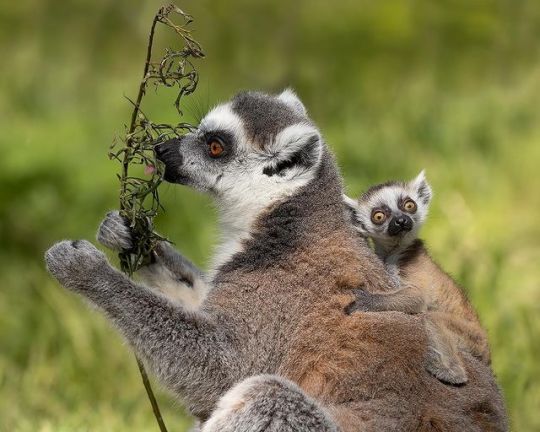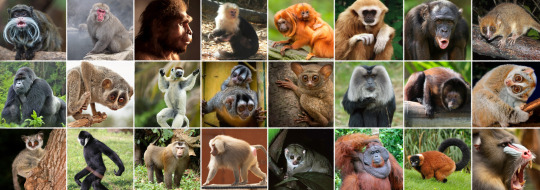#strepsirrhini
Text

A pair of brown greater galagos (Otolemur crassicaudatus) in Mkhuze Game Reserve, South Africa
by Ik_kil
#brown greater galago#galagos#prosimians#otolemur crassicaudatus#otolemur#galagidae#strepsirrhini#primates#mammalia#chordata#wildlife: south africa#wildlife: africa
112 notes
·
View notes
Text

Darwinius, an Eocene primate. What is perhaps even more amazing than the creature itself is the fact that the name Darwinius was still available by 2009.
#darwinius#strepsirrhini#primate#mammal#paleogene#senckenberg museum#palaeoblr#seriously how did no-one snap up 'darwinius' yet by that point
66 notes
·
View notes
Text

i'm the luckiest ahkj fan in existence
25 notes
·
View notes
Video
Ring-tailed lemur (Lemur catta)
#lemur#ring tailed lemur#animals#animal#nature#wildlife#wild animals#endangered animals#endangered species#endangered wildlife#video#animal video#animal videos#lemur catta#primate#primates#chordata#mammal#mammalia#strepsirrhini#lemuridae
31 notes
·
View notes
Photo

Ring-tailed Lemur
14 notes
·
View notes
Photo

Zahzu
Met the cool Zahzu at the leemie meet in Apenheul last month.
Digital version of the sketch I did for her that day.
13 notes
·
View notes
Text
Studies of mitochondrial DNA suggest the Strepsirrhini suborder, containing the ancestors of Madagascar's lemurs, diverged from our own Haplorhini suborder approximately 64 million years ago, which implies that a common ancestor was present before this time, but not a great deal earlier.

"Human Universe" - Professor Brian Cox and Andrew Cohen
#book quotes#human universe#brian cox#andrew cohen#nonfiction#mitochondrial dna#strepsirrhini#madagascar#lemur#haplorhini#evolutionary tree#evolutionary history#hominids#platyrrhini#catarrhini#cercopithecoids#hominoids#hylobatids#spider monkey#macaque#proconsul#siamang#sivapithecus#gibbon#orangutan#ouranopithecus#dryopithecus#gorilla#chimpanzee#human
0 notes
Text
aye aye of a boy....
#SOOOO fucking true#why would i blog on this website if squick wasnt here. someone answer quickly#talking abt aye ayes instantly flashed me back to my mammalogy class#during the unit on strepsirrhini. zoology degree moment
1 note
·
View note
Text

🦍The primate tournament list of candidates has been finalised! Polls will start going up soon!🦧
Thank you to everyone who submitted a species! Here is the full written list:
Basal primates (non-simian primates, including Strepsirrhini and Tarsiiformes)
†Notharctus (Notharctus tenebrosus)
Calabar angwantibo (Arctocebus calabarensis)
West African potto (Perodicticus potto)
Red slender loris (Loris tardigradus)
Bengal slow loris (Nycticebus bengalensis)
Pygmy slow loris (Xanthonycticebus pygmaeus)
Senegal bushbaby (Galago senegalensis)
Brown greater galago (Otolemur crassicaudatus)
Ring-tailed lemur (Lemur catta)
Verreaux’s sifaka (Propithecus verreauxi)
†Archaeoindris (Archaeoindris fontoynontii)
†Megaladapis (Megaladapis madagascariensis)
Madame berthe’s mouse lemur (Microcebus berthae)
Aye-aye (Daubentonia madagascariensis)
Philippine tarsier (Carlito syrichta)
Pygmy tarsier (Tarsius pumilus)
New world monkeys (Platyrrhini)
Wied’s marmoset (Callithrix kuhlii)
Goeldi’s marmoset (Callimico goeldii)
Bearded emperor tamarin (Saguinus imperator subgrisescens)
Golden-headed lion tamarin (Leontopithecus chrysomelas)
Panamanian white-faced capuchin (Cebus imitator)
Central American squirrel monkey (Saimiri oerstedii)
Gray-bellied night monkey (Aotus lemurinus)
Bald uakari (Cacajao calvus)
Madidi titi monkey (Plecturocebus aureipalatii)
Atlantic titi monkey (Callicebus personatus)
Black bearded saki (Chiropotes satanas)
White-faced saki (Pithecia pithecia)
Colombian red howler (Alouatta seniculus)
Brown spider monkey (Ateles hybridus)
Northern muriqui (Brachyteles hypoxanthus)
Yellow-tailed woolly monkey (Lagothrix flavicauda)
Old world monkeys (Cercopithecidae)
Mantled guereza (Colobus guereza)
Zanzibar red colobus (Piliocolobus kirkii)
Nepal gray langur (Semnopithecus schistaceus)
Silvery lutung (Trachypithecus cristatux)
Golden snub-nosed monkey (Rhinopithecus roxellana)
Proboscis monkey (Nasalis larvatus)
Red-shanked douc (Pygathrix nemaeus)
Collared mangabey (Cercocebus torquatus)
Japanese macaque (Macaca fuscata)
Rhesus macaque (Macaca mulatta)
Hamadryas baboon (Papio hamadryas)
Mandrill (Mandrillus sphinx)
Gelada (Theropithecus gelada)
Common patas monkey (Erythrocebus patas)
Bale mountains vervet (Chlorocebus djamdjamensis)
De brazza’s monkey (Cercopithecus neglectus)
Apes (Hominoidea)
Lar gibbon (Hylobates lar)
Pileated gibbon (Hylobates pileatus)
Kloss’s gibbon (Hylobates klossii)
Northern white-cheeked gibbon (Nomascus leucogenys)
Siamang (symphalangus syndactylus)
†Junzi (Junzi imperialis)
Bornean orangutan (Pongo pygmaeus)
†Gigantopithecus (Gigantopithecus blacki)
†Dryopithecus (Dryopithecus fontani)
Western lowland gorilla (Gorilla gorilla gorilla)
Chimpanzee (Pan troglodytes)
Bonobo (Pan paniscus)
†Australopithecus (Australopithecus afarensis)
†Panranthropus (Panranthropus boisei)
†Flores hobbit (Homo floresiensis)
†Neanderthal (Homo neanderthalensis)

The first set of polls will go up as soon as I have finished writing the descriptions! In the meantime, I would appreciate if you could share this tournament around- it won’t be much of a tournament if there aren’t that many people voting! In going down the research rabbit hole I’ve found so many interesting species and stories, and I promise learning about them here will be worth your time!
#primate bracket#tournament#tumblr tournament#poll#polls#primate#primates#extinct primates#biology#animals#zoology#please let me know if I made a mistake anywhere!
97 notes
·
View notes
Text
Synapsic Info
History / Interactions with Humans
Synapsics are an alien race that first descended to earth near the beginning of the Meghalayan age. Their numbers were scarce with only around 50 or lower being alive at a given time. They stayed under the radar for many years, only being found as a separate species in the year 1612. Their low numbers continued to dwindle despite human intervention. In 2604, a second generation descended and the population was saved. Synapsics were recognized as intelligent beings in 2637. Before being discovered by humans, Synapsics would live in small groups in the wild. If they looked humanoid enough they might’ve dwelled in unsuspecting towns or cities. Most had little to no contact with humans, being neither hostile nor friendly. In later years, especially after 2637 and the years following, Synapsics lived alongside humans. Upon being introduced into human society, Synapsics began to attend schools and work at jobs. Many housed with and continue to house with humans in apartments or houses. Human/Synapsic marriage and dating was a highly controversial topic that never really got resolved before the extinction of humans.
Diet / Behaviour
Synapsics are purely carnivorous. Their bodies change to mimic the attributes of its prey whether that be rodents, livestock, or even humans. Their name comes from their main diet being made up of mammals of the Synapsida clade. When a Synapsic hunts for the first time, it will eat whatever it catches for the rest of its life. Due to mostly mimicking mammals, Synapsics are viviparous; meaning live bearing opposed to oviparous which is egg laying. Synapsics rarely reproduce due to their long lifespans of around 150-200 years or by simply having a lack of desire in the act. Some can even live up to 500 years under the right conditions. When they do reproduce however they experience the same gestation period and any other factors that the organism their mimicking would experience.
Subspecies
As Synapsics eat the same prey over and over again, they will develop attributes similar to their meal (Ears, Tail, Fur, Etc.). Subspecies have been given to each morph based on the family, superfamily, or suborder of the mimicked prey.
Tenreform (Tenrecomorpha Suborder | Tenrecs, Shrews)
Caniform (Canidae family | Dogs, Foxes, Wolves)
Ursiform (Ursidae family | Bears)
Mustelform (Musteloidea superfamily | Skunks, Badgers, Weasels, Otters, Racoons, Etc.)
Pinniform (Pinniped clade | Walruses, Seals, Sea lions)
Feliform (Felidae family | Cats (Domestic + Wild)
Vivierrform (Vivierridae family | civets, genets, oyans)
Herpeform (Herpestoidea superfamily | Hyenas, Mongooses, Euplerids)
Tyloform ( Tylopoda suborder | Camels)
Suinaform (Suina suborder | Pigs, Hogs, Peccaries)
Whippoform (Whippomorpha suborder | Hippos, Whales, Dolphins, Etc.)
Rumiform (Ruminantia suborder | Deer, Giraffes, Mooses, Buffalo, Antelope, Gazelle, Sheep, Etc.)
Chiroform (Chiroptera order | Bats)
Cingulaform (Cingulata order | Armadillos)
Didelform (Didelphidae family | Opossums)
Diproform (Diprotodontia order | Kangaroos, Wallabies, Possums, Koalas, Wombats)
Lagoform (Lagomorpha order | Rabbits, Hares, Pikas)
Monotreform (Monotremata order | Platypus, Echidnas)
Perissoform (Perissodactyla order | Horses, Rhinos, Tapirs)
Piloform (Pilosa order | Sloths, Anteaters)
Hominiform (Hominidae family | Humans, Chimps, Gorillas, Etc.)
Strepsiform (Strepsirrhini suborder | Lemurs, Bushbabies, Galagos, Lorises)
Elephform (Elephantidae family | Elephants)
Castoriform (Castorimorpha suborder | Beavers, Gophers, Pocket Mice)
Myoform (Myomorpha suborder | Jerboas, Mice, Voles, Rats, Hamsters)
Sciuroform (Sciuromorpha suborder | Dormice, Squirrels)
Scandentiform (Scandentia order | Treeshrews)
Sireform (Sirenia order | Dugongs, Manatees)
Orycteroform (Orycteropodidae family | Aardvarks)
#roblox#roblox flicker#robloxflicker#flicker#flicker roblox#flicker au#original species#infodump#personal essay
4 notes
·
View notes
Text

A family of white footed sportive lemurs (Lepilemur leucopus) in Madagascar
by Laurence Green
#white footed sportive lemur#sportive lemurs#lemurs#lepilemur leucopus#lepilemur#lepilemuridae#strepsirrhini#primates#mammalia#chordata#wildlife: madagascar#wildlife: africa#prosimians
159 notes
·
View notes
Text
One of the weirder things that makes sense if you're a biology nerd is the Pokemon Shroodle evolving into Grafaiai because some of the only mammals with a venomous bite are certain species of shrews and the slow loris.
Now I hear you saying "Slow loris and aye-aye aren't the same primates though!" but its notable Grafaiai's design doesn't seem to only be based on an aye-aye. Like its tail and facial markings seem to be based on ring-tailed lemurs for example


In short Grafaiai seems to be an amalgamation of suborder strepsirrhini which includes the aye-aye, lemurs and lorises (among others) which lines up well with Shroodle not being based on one specific member of the shrew family either. It's all quite clever!
16 notes
·
View notes
Text
snacking lemur sounds
#i use this as asmr#ahkj#all hail king julien#king julien#my first video edit guys#lemur catta#lemur#strepsirrhini
18 notes
·
View notes
Photo

Ring-tailed Lemur
7 notes
·
View notes
Text
🦍Markhor’s menagerie masterpost🐫
🦧Primates🐒
.
Primate kin
Colugos. Not quite primates, but I love them anyway.
.
Basal primates
Basal animals are those which are closer to the base of a particular section of the tree of life. A more traditional word for this concept is primitive. So for example, amphibians are basal land vertebrates. Here I have classified basal primates as any which are not monkeys and/or apes, including Strepsirrhini and Tarsiiformes.
Lemurs
A group of basal primates found exclusively on the island of Madagascar.
.
New world monkeys
Monkeys which are native to the “new world”, or the Americas. They are the only non-human primates found here. It is thought they arrived to the Americas tens of millions of years ago, when a group of African monkeys were blown out to sea by a storm. They survived the journey across the Atlantic on a natural raft of floating vegetation, and founded a new group of primates: Platyrrhini.
.
Old world monkeys
These are monkeys native to the “old world”: Africa and Eurasia. Also known as Cercopithecidae.
.
Apes
A group of large old world monkeys most recognisable by their lack of a tail. More formally known as Hominoidea.
Lesser apes
Consists of all the gibbon species, found in the treetops all across Southeast Asia.
Great apes
Includes orangutans, gorillas, chimpanzees, and humans. All living species of great ape have been documented using tools.
🐫Ungulates🐃
.
Odd-toed ungulates
Odd-toed ungulates, of course, have an odd number of hooves. They include horses, tapirs, rhinos, and their extinct relatives. They might actually be less closely related to even-toed ungulates than you’d think!
.
All ungulates from here on out are Even-toed ungulates:
These have an even number of hooves, and include most living hoofed mammals. Whales are technically included in this group, but they’re best left for another time.
.
Camelidae
Consists of camels, llamas, and their extinct relatives. They are often adapted for harsh climates such as deserts and mountains.
2 notes
·
View notes
Text
https://en.wikipedia.org/wiki/Strepsirrhini
1 note
·
View note